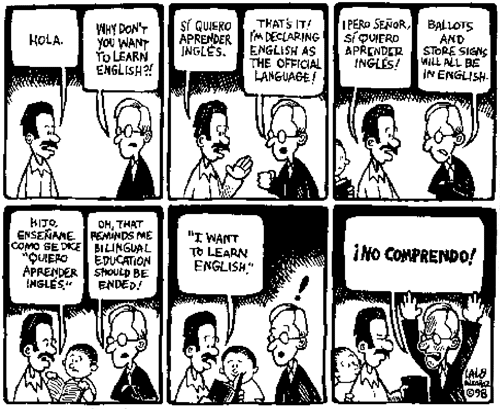|
According to Carlos Ovando (2003), the history of bilingual education can be divided into four distinctive periods: Permissive,
Restrictive, Opportunist, and Permissive. Below is an overview of these periods:
Permissive Period: 1700-1880's
-A fair amount of tolerance existed between the many languages of the new society. Because there was a lot of expansion
during this time, people would just move if they did not like their neighbors.
-There was a strong sense of identity tied to a person's ancestral language, so many held on to their language for religious
services, community newspapers, and SCHOOLS.
-This period alluded to the fact that there may be room for bilingual programs or at least accommodation.
The Restrictive Period: 1880's-1960's
-During the 1880's, repressive Indian language policy was part of a cultural genocide campaign designed to "civilize"
Indians and contain them on reservations.
-Due to high European nationalism in this time, there was a fear of foreign ideologies which led to the United States
wanting all immigrants to fit one cultural mold. This spurred the Naturalization Act of 1906 which states "to become
naturalized U.S. citizens, immigrants must be able to speak English" (p.3). This led to a huge push for homogeneity
in schools and emphasized monolingual English instruction in public schools.
The Opportunist Period: 1960's-1980's
-"World War II served as the first wake-up call regarding the United States' inadequacies in foreign-language instruction.
Because language, math, and science skills were essential for military, commercial, and diplomatic endeavors, these subjects
became a high priority in the national defense agenda during the cold war period" (p.4).
-Civil Rights Movement also led the way for a rebirth in bilingual education. "For the first time in American educational
history, the federal government embarked on an educational experiment that sought to build upon students' home cultures, languages,
and prior experiences in such a way that they could start learning without first being proficient in English" (p.5).
-From the Lau vs. Nichols case, equal educational opportunity became more than just providing the same materials and books
for students. Equal educational opportunity now included providing adequate and meaningful instruction for English learners.
Dismissive Period: 1980's-Present
-Despite the fact of moving forward with promoting bilingual education during the Opportunist period, the battle against
bilingual education grew during the 1980's.
-President Reagan stated, "It is absolutely wrong and against American concepts to have a bilingual education program
that is now openly, admittedly dedicated to preserving their native language and never getting them adequate in English so
they can go out into the job market and participate" (p.7). Due to his adminstration, there was a shift in funds for
English only instruction.
-More recently, California passed Proposition 227 which eliminated all bilingual programs in the state. A few other states,
Arizona and Colorado, followed in their footsteps.
|
 |
|
|
|
 |
|

Important policies and court cases that shaped bilingual education:
-Naturalization Act of 1906: stated "that to become naturalized U.S. citizens, immigrants must be able to speak English."
-1923 Meyer vs. Nebraska: the Supreme Court declared Nebraska's prohibition against teaching foreign languages in elementary
schools to be unconstitutional on the basis of the 14th Amendment.
-1968 Bilingual Education Act: aim was to "to support educational programs, to train teachers and aides, to develop
and disseminate instructional materials, and to encourage parental involvement" (p.5).
-1974 Lau vs. Nichols: this was seen as the most important decision for language-minority students. Chief Justice Douglas's
decision was "There is no equality of treatment merely by providing students with the same facilities, textbooks, teachers,
and curriculum; for students who do not understand English are effectively foreclosed from any meaningful education... .We
know that those who do not understand English are certain to find their classroom experiences wholly incomprehensible and
in no way meaningful" (Lau v. Nichols, 1974).
-1981 Castaneda vs. Pickard: established a three step process for deciding whether or not a school was taking appropriate
action for bilingual learners. Three steps are: (a) The school program must be anchored in sound educational theory, (b)
adequate resources and personnel must be evident in the school program, and (c) the school program must reflect sound practices
and results, not only in language but also in such content areas as math, science, social studies, and language arts.
-Proposition 227: California eliminated bilingual education programs saying that "English should be the primary medium
of instruction for language-minority students" (p.8).
-No Child Left Behind: standardized tests are biased towards ELL's due to the fact teachers are going through material
much faster and not taking the time to correct students or work with them on their English. They are so focused on making
sure all the material is covered for the test. It is going back to the sink-or-swim method.
|
 |
|
|
|

